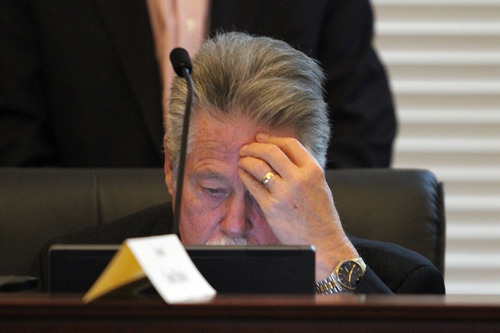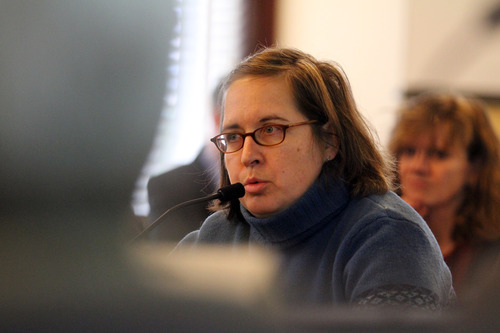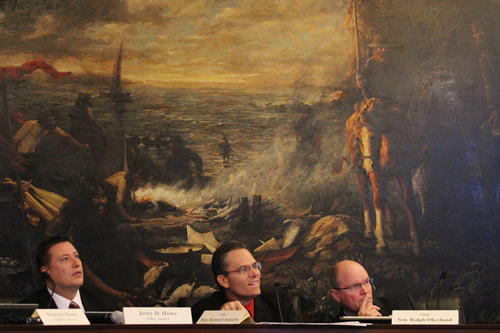This is an archived article that was published on sltrib.com in 2011, and information in the article may be outdated. It is provided only for personal research purposes and may not be reprinted.
Lawmakers began a Redistricting Committee hearing on Friday in a stalemate over how to redraw congressional districts. They ended it that way, too.
But in between, Democrats and reform groups zinged Republicans for earlier closed-door meetings that included discussions about how to draw all districts to be at least 62 percent Republican. The committee also examined a dozen maps as possible compromises, but did not act on any of them.
In the end, senators said they still like the plan they passed earlier this week that also had been endorsed earlier by the committee — and said it is up to the House to decide now whether to pass it or change it, and how.
But, "The House is still split," said Rep. Ken Sumsion, R-American Fork, the House chairman of the joint Redistricting Committee.
He said House GOP leaders plan to ask members about preferences on their next move. If they want more than mere adjustments to the Senate map, they may call the committee back to act on a compromise plan next week. Otherwise, they will wait for the full Legislature to reconvene as planned on Oct. 17.
Work on congressional maps skidded to a halt Tuesday as House and Senate Republicans deadlocked during a special session on redistricting, and called a two-week time out to seek compromise.
House Speaker Becky Lockhart, R-Provo, said House Republicans have a "fairly large list" of problems with the Senate-passed map. Many interviewed said House members sought maps that may favor the GOP more, help rural candidates more and differently decide how many Republicans from Davis County should be put in the district of Rep. Jim Matheson, D-Utah.
The Senate map would divide Salt Lake County into three slices. Two of them would be combined with vast rural areas. The third, in western Salt Lake County, would be combined with western, rural Utah County. A fourth district would be created in northern Utah.
Republicans say such a "pizza-slice" plan would ensure all members of Congress would represent both rural and urban areas. Democrats say that is a ploy to dilute their votes in Democratic Salt Lake County to improve odds of electing Republicans in all districts.
—
Behind closed doors • The hearing Friday to publicly examine possible compromise maps came in part because of complaints on Tuesday by Democrats and reform groups that Republicans had been busy attempting to draw new plans behind closed doors without public input.
Republicans groused Friday at that characterization and said they were debating among themselves about existing maps. Lockhart said, "We were not drawing maps in our caucus room."
"Were you singing Broadway songs?" replied Utah Democratic Party Chairman Jim Dabakis. "If physical maps were not being done, it was close enough."
Dabakis added, "The fix is in. It's about raw political power. It's getting Republican percentages right so you can ensure yourselves continuing 10 years in those congressional seats. ... It's the only way these maps can be justified."
Reform groups and Democrats — noting that the committee had vowed not to consider any partisan data in its work — were upset at press reports that House Republicans were pushing to ensure that all districts would be at least 62 percent Republican to help ensure defeat of Matheson.
Sen. Ben McAdams, D-Salt Lake City, asked Republicans if that had indeed been discussed in their closed-door meetings.
"Numbers were discussed, but they weren't the driving force of the maps," said Rep. Don Ipson, R-St. George. He said Republicans, in fact, realized "that the maps couldn't be drawn and couldn't be picked based on those numbers" He added that Democrats as well as Republicans had used partisan data to judge maps.
But McAdams said Republicans have drawn maps so that it is likely that Salt Lake County — the state's most populous — may not have any members of Congress from it after the next election, except perhaps state Rep. Carl Wimmer, R-Herriman, in the new 4th District.
—
Urban-rural mix • Republicans have said repeatedly that their top concerns in drawing maps are not partisanship, but instead equalizing population between districts and creating an urban-rural mix in each.
About that rural-urban mix and resulting "pizza slice" plans, Glenn Wright, board member of Fair Boundaries, said, "That is just a smokescreen for trying to create partisan-designed districts."
Rachel Carter with Peaceful Uprising said, "When we learn of factors that are so partisanly driven, that are so unfairly based, it's a major cause of concern for us. It is something we must protest profoundly."
Mary Bishop, chair of the Salt Lake County Democratic Party, said people "want this to be an open process. Don't draw these maps behind closed doors. Show the public what you are doing and compromise."
Lockhart said after the meeting that holding future open Republican caucuses to discuss maps "is definitely an option. I would be OK with that," to help overcome complaints about secrecy.
Senators have said one reason they recessed Tuesday was to help avoid repeating the public uprising that occurred earlier this year over late, secretive moves to rewrite Utah's open-records law by having late, secretive changes in redistricting.
"It's a shadow over this process," Lockhart said. "I would like to move past that. We have worked very hard to make this a very open and transparent process, and it's quite frustrating to hear that being brought up again and again and again."















